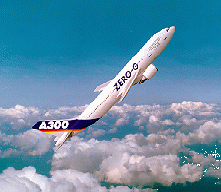The most striking result is that the collision frequency of particles does not increases linearly with the number of particles in the container as expected for usual gases. Due to the dissipative nature of collisions, the mean velocity of particles thus depends on the number of particles. When the number of particles in the container is doubled, the kinetic energy of particles thus is not doubled (this is not an extensive variable).
These results have been published in Europhysics Letters in 2006.
 Parabolic
flights are used to conduct short-term microgravity
scientific and technological investigations, to test instrumentation
prior to use in space, to validate operational and experimental
procedures, and to train astronauts for a future space flight.
Parabolic
flights are used to conduct short-term microgravity
scientific and technological investigations, to test instrumentation
prior to use in space, to validate operational and experimental
procedures, and to train astronauts for a future space flight.
Such flights are conducted on specially-configured aircraft , and provide a period of up to 20 seconds of reduced gravity or weightlessness. During a flight campaign , which normally consists of three individual flights, around 30 parabolas are flown on each flight, i.e. around 90 parabolas in total. On each parabola, there is a period of increased gravity (1.8 g) which lasts for 20 seconds immediately prior to and following the 20 second period of reduced gravity.
ESA performed its performed its 24th campaign using the newly available Airbus A-300 Zero-G aircraft of CNES in September 1997, and it is this aircraft that has been used ever since. The Airbus A-300 Zero-G is operated out of the Bordeaux-Mérignac airport by the company Novespace.
(Source: http://www.spaceflight.esa.int/users/file.cfm?filename=miss-parafl-30-phys-5)